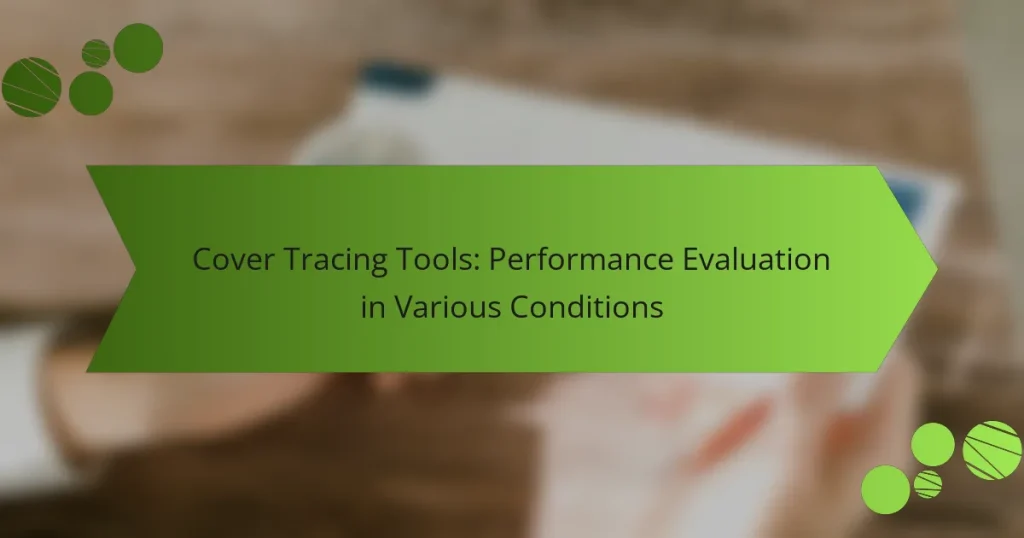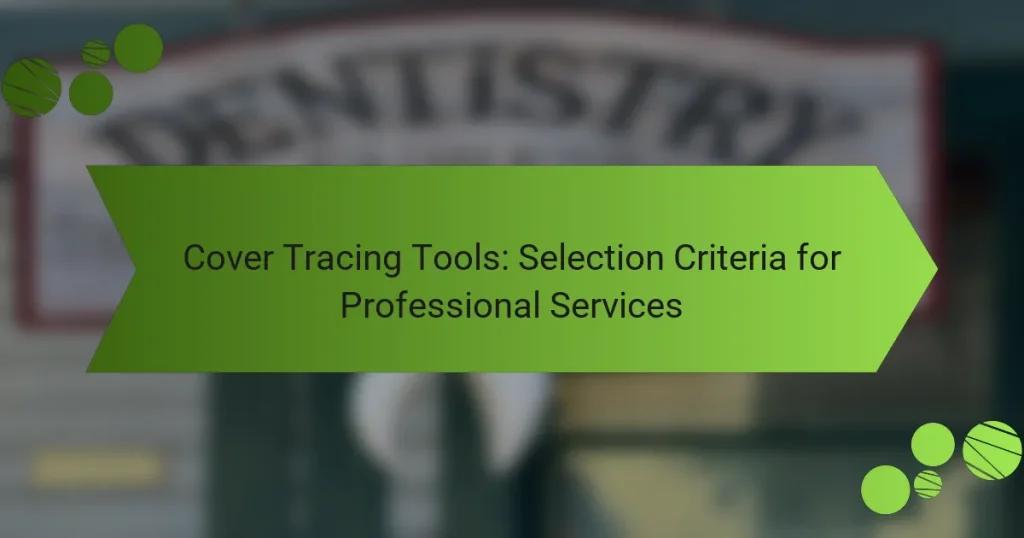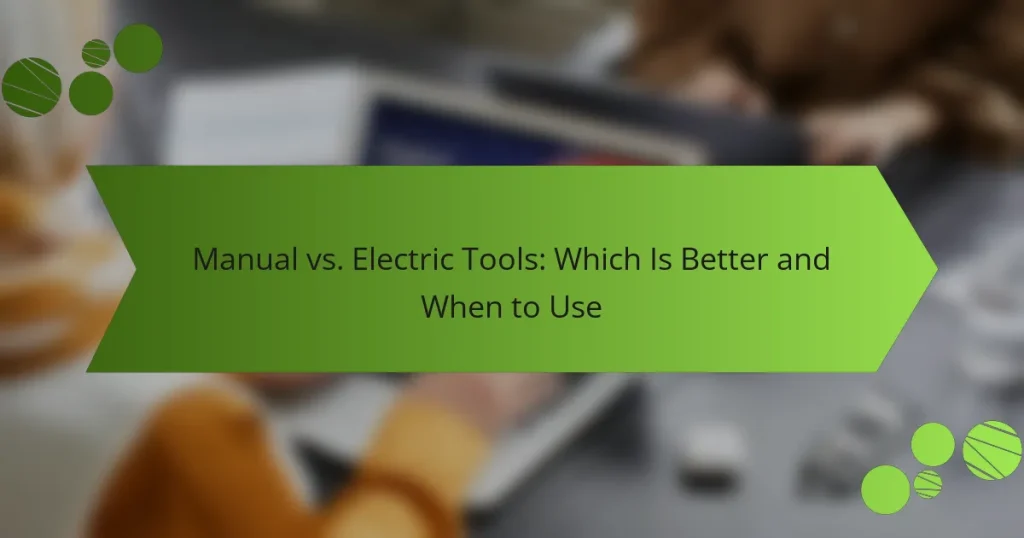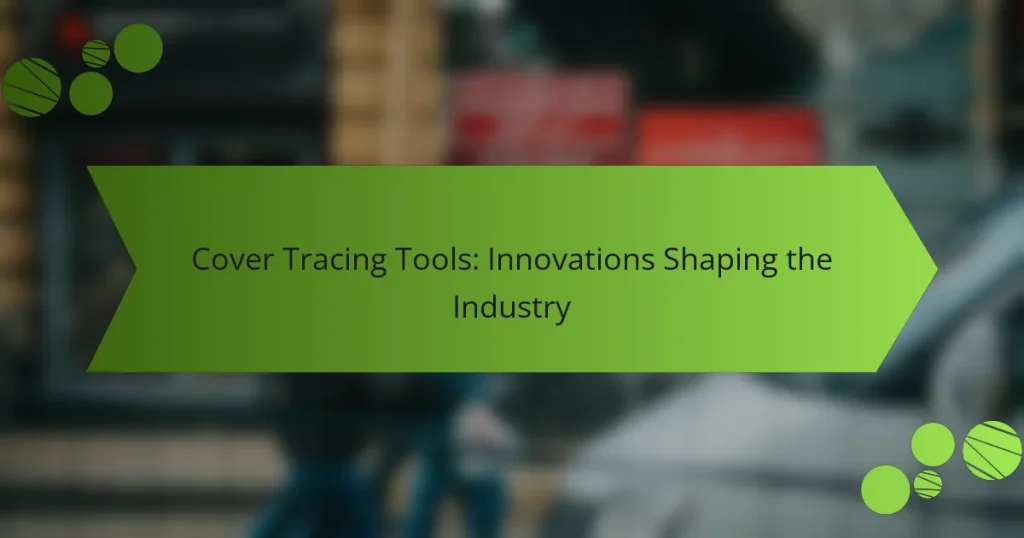Effective cover tracing tools are essential for enhancing accuracy and efficiency in construction projects. Software options like AutoCAD, Bluebeam Revu, and Revit provide unique features that streamline the creation and management of construction drawings. By automating documentation and tracking changes, these tools facilitate quicker decision-making and allow teams to concentrate on critical tasks.
Cover Tracing Tools: Selection Criteria for Professional Services
Manual vs. Electric Tools: Which Is Better and When to Use
Cover Tracing Safety Equipment: Essential Gear for Projects
Cover Tracing Tools: Budget-Friendly Options for Homeowners
Cover Tracing Tools: Essential Options for DIY Projects
Cover Tracing Tools: Innovations Shaping the Industry
What are the best cover tracing tools for construction projects?
The best cover tracing tools for construction projects include software that enhances accuracy and efficiency in creating and managing construction drawings. Popular options like AutoCAD, Bluebeam Revu, SketchUp, Revit, and PlanGrid each offer unique features tailored to different aspects of construction planning and execution.
AutoCAD
AutoCAD is a leading software in the construction industry, known for its precision in creating detailed 2D and 3D drawings. It allows users to draft and edit designs with a high degree of accuracy, making it ideal for cover tracing in architectural projects.
When using AutoCAD for cover tracing, ensure you utilize layers effectively to manage different elements of your design. This can help avoid confusion and streamline the editing process. Familiarize yourself with AutoCAD’s various tools, such as the Polyline and Hatch functions, to enhance your tracing efficiency.
Bluebeam Revu
Bluebeam Revu is a powerful PDF editing tool specifically designed for the construction industry. It enables users to create, edit, and annotate PDF documents, making it an excellent choice for cover tracing and collaboration among project stakeholders.
Utilize Bluebeam’s markup tools to highlight key areas in your cover tracing, and take advantage of its cloud collaboration features to share updates in real-time. This can significantly improve communication and reduce errors during the construction process.
SketchUp
SketchUp is a user-friendly 3D modeling software that is popular among architects and designers. It allows for quick visualization of projects, making it easier to create cover traces that accurately represent the intended design.
For effective cover tracing in SketchUp, leverage its extensive library of pre-made models and components. This can save time and enhance the overall quality of your designs. Be mindful of the software’s limitations in handling complex details, which may require additional tools for precision.
Revit
Revit is a Building Information Modeling (BIM) software that supports multidisciplinary collaborative design. It is particularly useful for cover tracing as it allows for detailed modeling of building components and systems.
When using Revit, focus on its parametric capabilities to create adaptable cover traces that can easily accommodate design changes. Ensure that all team members are trained in Revit to maximize its collaborative features and maintain consistency across the project.
PlanGrid
PlanGrid is a construction management software that specializes in document management and field collaboration. It is particularly effective for cover tracing as it allows users to access and annotate plans directly on-site using mobile devices.
To make the most of PlanGrid, regularly update your project documents and ensure all team members have access to the latest versions. This will help prevent discrepancies and keep everyone aligned on the project’s progress and requirements.
How do cover tracing tools improve project efficiency?
Cover tracing tools enhance project efficiency by automating the documentation and tracking of project changes. This leads to faster decision-making and reduced time spent on manual updates, allowing teams to focus on critical tasks.
Streamlined documentation
Streamlined documentation is a key benefit of cover tracing tools, as they automatically generate and update project records. This reduces the need for manual entry, which can be time-consuming and prone to errors.
For example, when a change is made in a project, the tool can instantly log this update in the documentation, ensuring that all team members have access to the latest information. This can save hours of work each week, especially in large projects with multiple stakeholders.
Enhanced collaboration
Enhanced collaboration is another significant advantage, as cover tracing tools provide a centralized platform for all project-related information. Team members can easily access, share, and discuss changes, which fosters better communication and teamwork.
Using these tools, teams can set permissions and track contributions, ensuring that everyone is on the same page. This transparency helps prevent misunderstandings and keeps the project moving forward smoothly.
Reduced errors
Cover tracing tools help reduce errors by minimizing manual data entry and providing real-time updates. By automating the tracking of changes, these tools decrease the likelihood of miscommunication and oversight.
For instance, if a team member forgets to update a document after a meeting, the tool can automatically reflect the latest changes, ensuring that everyone is working with accurate information. This can significantly lower the risk of costly mistakes that arise from outdated or incorrect data.
What features should I look for in cover tracing tools?
When selecting cover tracing tools, prioritize features that enhance accuracy, compatibility, and ease of use. Key aspects include 3D modeling capabilities, integration with other software, and a user-friendly interface to streamline your workflow.
3D modeling capabilities
3D modeling capabilities are essential for creating realistic and accurate representations of covers. Look for tools that allow you to manipulate dimensions, textures, and lighting to achieve a professional finish. Some tools offer features like real-time rendering, which can significantly speed up the design process.
Consider tools that support various file formats, enabling you to import and export models easily. This flexibility ensures compatibility with other design software, allowing for a seamless workflow.
Integration with other software
Integration with other software is crucial for maximizing efficiency in your design projects. Choose cover tracing tools that can easily connect with graphic design programs, project management software, and cloud storage solutions. This connectivity allows for smoother collaboration and data sharing.
Evaluate the available APIs and plugins that facilitate these integrations. Tools that offer extensive compatibility can save time and reduce errors by minimizing the need for manual data entry.
User-friendly interface
A user-friendly interface enhances productivity by making the tool accessible to users of all skill levels. Look for intuitive layouts, customizable dashboards, and helpful tutorials that guide you through the features. A well-designed interface reduces the learning curve and allows you to focus on your creative work.
Additionally, consider tools that offer responsive customer support and active user communities. These resources can provide assistance and tips, further improving your experience with the software.
What are the pricing options for cover tracing tools?
Cover tracing tools typically offer various pricing options to accommodate different user needs and budgets. The most common models include subscription services, one-time purchases, and free trials, each with its own advantages and considerations.
Subscription models
Subscription models charge users a recurring fee, often monthly or annually, for access to cover tracing tools. This option usually includes regular updates and customer support, making it a good choice for users who require ongoing access and features. Prices can range from around $10 to $50 per month, depending on the tool’s capabilities and the level of service provided.
When choosing a subscription model, consider the frequency of use and the specific features needed. Some tools may offer tiered pricing based on usage limits or additional functionalities, so evaluate what best fits your requirements.
One-time purchase
One-time purchase options allow users to buy cover tracing tools outright, providing a permanent license for the software. This can be a cost-effective solution for those who need the tool for a specific project or infrequent use. Prices for one-time purchases typically range from $100 to $500, depending on the complexity and features of the tool.
While this option eliminates ongoing costs, users should be aware that updates may require additional purchases or fees. Ensure the tool meets your long-term needs before committing to a one-time payment.
Free trials
Many cover tracing tools offer free trials, allowing users to test the software before making a financial commitment. These trials usually last from a week to a month and provide access to most features, helping users assess the tool’s effectiveness for their specific needs.
Take advantage of free trials to explore different tools and compare their functionalities. Keep an eye on the trial’s expiration date to avoid unexpected charges, and consider documenting your experience to inform your final decision.
What are the prerequisites for using cover tracing tools?
To effectively use cover tracing tools, users need a solid foundation in basic software skills and a clear understanding of construction plans. These prerequisites ensure that users can navigate the tools efficiently and interpret the data accurately.
Basic software knowledge
Having basic software knowledge is essential for using cover tracing tools. Users should be comfortable with operating systems and familiar with software interfaces, as these tools often require navigation through various menus and options. Understanding file management, such as saving and exporting data, is also crucial.
Additionally, proficiency in spreadsheet software can be beneficial. Many cover tracing tools allow users to export data into formats compatible with programs like Excel, where further analysis and manipulation can take place. Familiarity with these applications can enhance the overall effectiveness of the tracing process.
Understanding of construction plans
A strong grasp of construction plans is vital when using cover tracing tools. Users must be able to read and interpret blueprints, which include symbols, dimensions, and specifications that detail the project. This understanding helps in accurately applying the tracing tools to the relevant areas of the plans.
Moreover, recognizing different types of construction documents, such as architectural drawings and structural plans, can aid in identifying where cover tracing is necessary. Users should familiarize themselves with common notations and standards used in their region, as these can vary significantly. This knowledge ensures that the tracing process aligns with the project’s requirements and regulatory standards.
How do cover tracing tools compare to traditional methods?
Cover tracing tools significantly enhance efficiency and precision compared to traditional methods. They automate the process of identifying and mapping coverage, which can save time and reduce human error.
Speed of execution
Cover tracing tools can execute tasks in a fraction of the time it takes traditional methods, often completing processes in low tens of milliseconds. This rapid execution is crucial in environments where time-sensitive decisions are necessary, such as in financial services or emergency response.
For instance, while manual tracing may take several minutes to hours, automated tools can provide results almost instantaneously. This speed not only improves workflow but also allows for quicker adjustments based on real-time data.
Accuracy of results
Accuracy is a key advantage of cover tracing tools over traditional methods. Automated systems typically achieve accuracy rates in the high nineties percentage-wise, minimizing the risk of errors that can occur with manual processes.
Moreover, these tools often incorporate advanced algorithms and machine learning techniques that continuously improve their performance. Users should ensure they select tools that comply with relevant industry standards to maximize reliability and trustworthiness in results.






